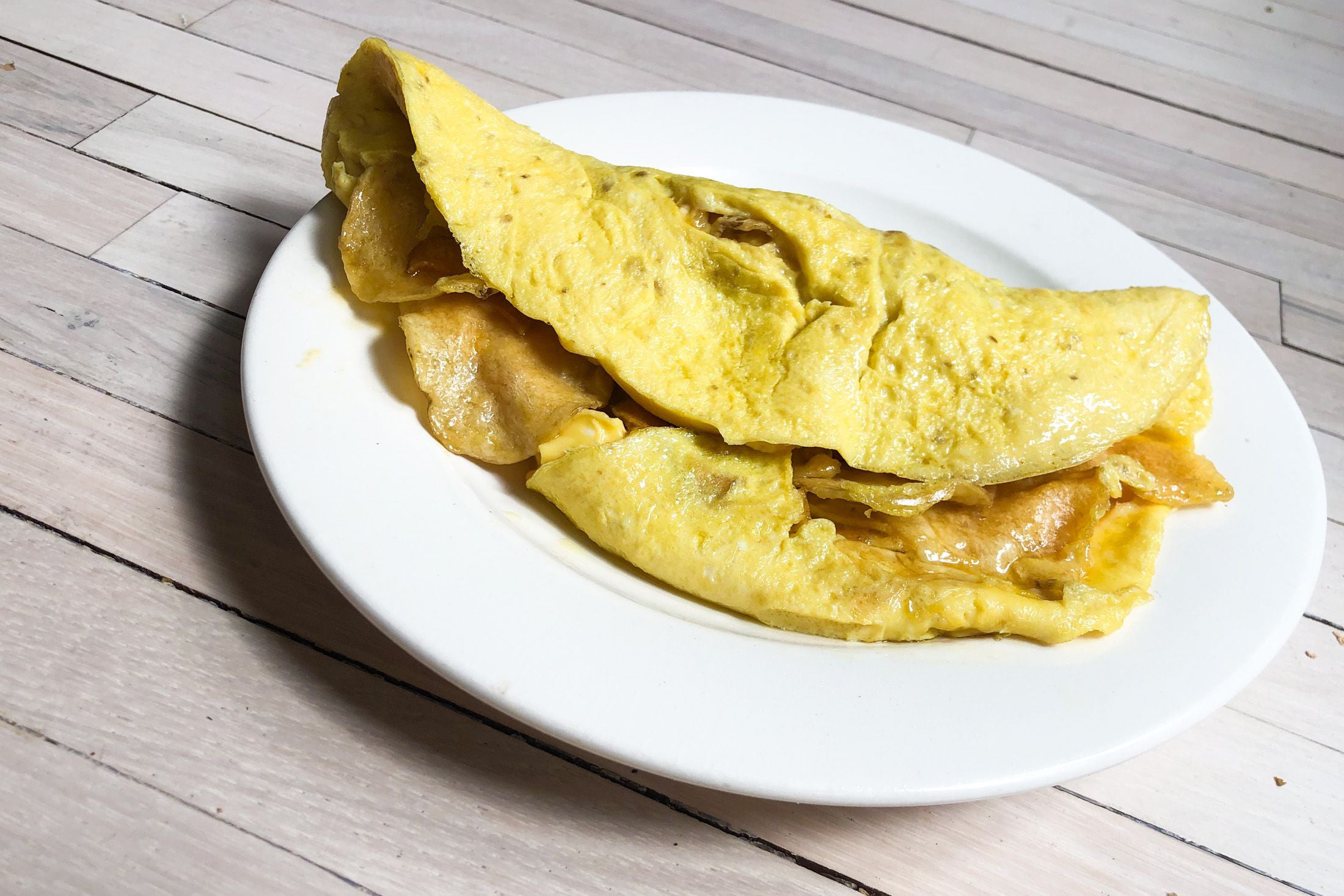Putting crisps in an omelette: questionable or delectable?
Even the world’s most avant-garde chef is also adept at preparing the simplest of dishes, from gazpacho to rice pudding. Kate Krader tries Ferran Adrià’s crisp omelette

It’s now standard practice for the world’s top chefs and restaurants to make themselves available to home cooks.
It’s a trend that the pandemic has only fast-tracked and has involved Rene Redzepi serving burgers at Noma in Copenhagen, Massimo Bottura making mac and cheese for a free online cooking class and the people behind Carbone selling jars of pasta sauce.
But a decade ago, when Ferran Adrià wrote The Family Meal: Home Cooking with Ferran Adrià, it was nothing short of sensational. At his restaurant El Bulli in Spain, such dishes as the “liquid olive” (olive juice transmogrified into a green fruit that popped in your mouth) and transparent “vanishing ravioli”, garnered him recognition as the world’s best chef.
El Bulli closed in 2011 after winning all the awards there were; the location is in the process of being turned into what Adrià calls “musealización” (being turned into a museum) that both preserves the legacy of his restaurant and promotes creativity. Concurrently, he’s started a book series on the origins of cooking.
A 10th anniversary edition of The Family Meal was published on 1 April to remind us that for all the accolades, the world’s most avant-garde chef is also adept at preparing the simplest of dishes, from gazpacho to rice pudding.
The reissued cookbook contains a new introduction from Adrià but the recipes are unchanged, as is the format. Dishes are divided into meals – melon with cured ham is followed by rice with duck and chocolate cake – that also include shopping lists, a preparation timeline and old-school-look step-by-step pictures.
Read more:
Even if the format is “Ferran Adrià goes to the supermarket”, his wild ingenuity breaks through occasionally. Consider his dessert of watermelon sprinkled with crushed menthol sweets. Along with the four basic taste sensations (salty, sweet, sour and bitter), we perceive “a series of nuances … among these nuances is menthol, which gives the palate a feeling of freshness”, he writes. He also advises anyone with a sous vide machine to use it to infuse the watermelon with the lemon syrup.
A more brilliant innovation is his three-ingredient crisp omelette. Even salt is rendered unnecessary by the crisps, which are folded into the beaten egg to soften slightly before cooking.
Top tips
- Use the freshest eggs you can get and top-of-the-line crisps and olive oil.
- One bag of crisps is around 40g – less is more with this recipe.
- Using a good non-stick frying pan will make inverting the omelette dead easy.
The result, especially if you’re adept at folding a cooked omelette over to hide the filling, is a surprise of crisps that infuse the eggs with potato flavour while adding a fun chewy, starchy bite. Imagine the best forkful of eggs with hash browns, yet melded more perfectly together. Plus, it’s simply a fun dish, especially for those who know that the omelette was historically the test of a great chef in classic restaurants.
“It came to my mind thinking about the cheese omelette. If we did not do the cheese, why not try using potato chips?” says Adrià, in an email. He’s an enduring fan of the recipe. “I normally cook it once a week.”
Because the ingredients list is so short, he recommends using the freshest eggs and best crisps and oil. “I make it with potato chips that have extra-virgin olive oil of the best quality,” he advises.
Innovators inspired by Adrià’s creativity should be advised that well-salted crisps are key to this equation – don’t underestimate the power of a plain, salted specimen, though sour cream and onion are always crowd-pleasers. If you want to experiment with something like the South Korean cult favourite honey-butter crisps, you will need to add salt; you might want to have some seasoning handy, anyway. Thickness counts, too: ridged crisps or kettle-cooked give a slightly firmer bite.
You can also serve the omelette with your favourite egg accoutrements: hot sauce, bacon, grated cheese. Before you add any, take a bite of Adrià’s omelette as it is and revel in its simple genius.
Potato crisp omelette
Serves 2
Ingredients
6 large eggs
78g (around two individual bags) salted crisps
1½tbsp olive oil, divided use
Method
Beat the eggs with a whisk until very frothy. Add the crisps – taking care not to break them up – and let them soak for 1 minute, gently pushing them into the eggs.
Place a 25cm non-stick frying pan over medium heat and add two teaspoons of the oil. Add the egg mixture and stir gently with a rubber spatula. Use the spatula to loosen the sides of the omelette from the edge of the pan. After 40-60 seconds, when the bottom of the omelette has set, cover the omelette with a plate. Holding on to the pan with one hand, carefully turn the pan over so the omelette slides on to the plate. Return the pan to the heat and add the remaining two teaspoons of oil. Slide the omelette from the plate into the pan and cook the uncooked side for 20-30 seconds longer. Transfer to a plate, cut in half and serve.
Tester’s note: For reference, a small bag of crisps is generally around 40g. Although the quantity need not be precise, you shouldn’t add more; err on the side of too little if you’re not weighing. Use a good non-stick pan.
From Ferran Adria’s The Family Meal.
© Bloomberg
Join our commenting forum
Join thought-provoking conversations, follow other Independent readers and see their replies
Comments